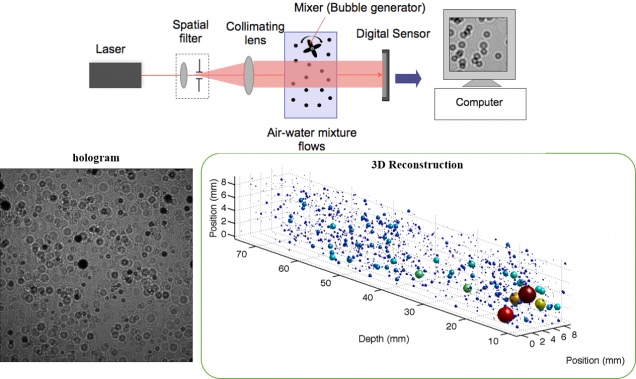Digital Holographic Imaging
Adaptive 3D descattering with a dynamic synthesis network
Waleed Tahir, Hao Wang, Lei Tian
Light: Science & Applications 11, 42, 2022
Deep learning has been broadly applied to imaging in scattering applications. A common framework is to train a “descattering” neural network for image recovery by removing scattering artifacts. To achieve the best results on a broad spectrum of scattering conditions, individual “expert” networks have to be trained for each condition. However, the performance of the expert sharply degrades when the scattering level at the testing time differs from the training. An alternative approach is to train a “generalist” network using data from a variety of scattering conditions. However, the generalist generally suffers from worse performance as compared to the expert trained for each scattering condition. Here, we develop a drastically different approach, termed dynamic synthesis network (DSN), that can dynamically adjust the model weights and adapt to different scattering conditions. The adaptability is achieved by a novel architecture that enables dynamically synthesizing a network by blending multiple experts using a gating network. Notably, our DSN adaptively removes scattering artifacts across a continuum of scattering conditions regardless of whether the condition has been used for the training, and consistently outperforms the generalist. By training the DSN entirely on a multiple-scattering simulator, we experimentally demonstrate the network’s adaptability and robustness for 3D descattering in holographic 3D particle imaging. We expect the same concept can be adapted to many other imaging applications, such as denoising, and imaging through scattering media. Broadly, our dynamic synthesis framework opens up a new paradigm for designing highly adaptive deep learning and computational imaging techniques.
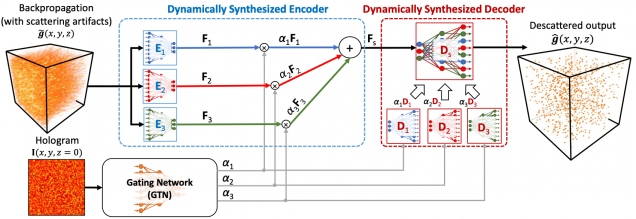
Roadmap on digital holography
Bahram Javidi, Artur Carnicer, Arun Anand, George Barbastathis, Wen Chen, Pietro Ferraro, J. W. Goodman, Ryoichi Horisaki, Kedar Khare, Malgorzata Kujawinska, Rainer A. Leitgeb, Pierre Marquet, Takanori Nomura, Aydogan Ozcan, YongKeun Park, Giancarlo Pedrini, Pascal Picart, Joseph Rosen, Genaro Saavedra, Natan T. Shaked, Adrian Stern, Enrique Tajahuerce, Lei Tian, Gordon Wetzstein, and Masahiro Yamaguchi
Optics Express Vol. 29, Issue 22, pp. 35078-35118 (2021).
This Roadmap article on digital holography provides an overview of a vast array of research activities in the field of digital holography. The paper consists of a series of 25 sections from the prominent experts in digital holography presenting various aspects of the field on sensing, 3D imaging and displays, virtual and augmented reality, microscopy, cell identification, tomography, label-free live cell imaging, and other applications. Each section represents the vision of its author to describe the significant progress, potential impact, important developments, and challenging issues in the field of digital holography.
Large-scale holographic particle 3D imaging with the beam propagation model
Hao Wang, Waleed Tahir, Jiabei Zhu, Lei Tian
Opt. Express 29, 17159-17172 (2021)
We develop a novel algorithm for large-scale holographic reconstruction of 3D particle fields. Our method is based on a multiple-scattering beam propagation method (BPM) combined with sparse regularization that enables recovering dense 3D particles of high refractive index contrast from a single hologram. We show that the BPM-computed hologram generates intensity statistics closely matching with the experimental measurements and provides up to 9× higher accuracy than the single-scattering model. To solve the inverse problem, we devise a computationally efficient algorithm, which reduces the computation time by two orders of magnitude as compared to the state-of-the-art multiple-scattering-based technique. We demonstrate superior reconstruction accuracy in both simulations and experiments under different scattering strengths. We show that the BPM reconstruction significantly outperforms the single-scattering method in particular for deep imaging depths and high particle densities.
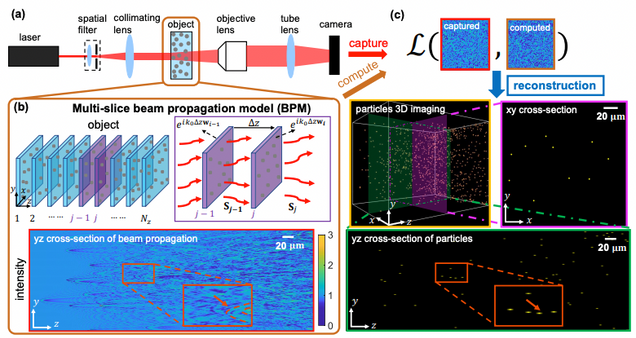
Holographic particle-localization under multiple scattering
Waleed Tahir, Ulugbek S. Kamilov, Lei Tian
Advanced Photonics, 1(3), 036003 (2019).
We introduce a computational framework that incorporates multiple scattering for large-scale three-dimensional (3-D) particle localization using single-shot in-line holography. Traditional holographic techniques rely on single-scattering models that become inaccurate under high particle densities and large refractive index contrasts. Existing multiple scattering solvers become computationally prohibitive for large-scale problems, which comprise millions of voxels within the scattering volume. Our approach overcomes the computational bottleneck by slicewise computation of multiple scattering under an efficient recursive framework. In the forward model, each recursion estimates the next higher-order multiple scattered field among the object slices. In the inverse model, each order of scattering is recursively estimated by a nonlinear optimization procedure. This nonlinear inverse model is further supplemented by a sparsity promoting procedure that is particularly effective in localizing 3-D distributed particles. We show that our multiple-scattering model leads to significant improvement in the quality of 3-D localization compared to traditional methods based on single scattering approximation. Our experiments demonstrate robust inverse multiple scattering, allowing reconstruction of 100 million voxels from a single 1-megapixel hologram with a sparsity prior. The performance bound of our approach is quantified in simulation and validated experimentally. Our work promises utilization of multiple scattering for versatile large-scale applications.
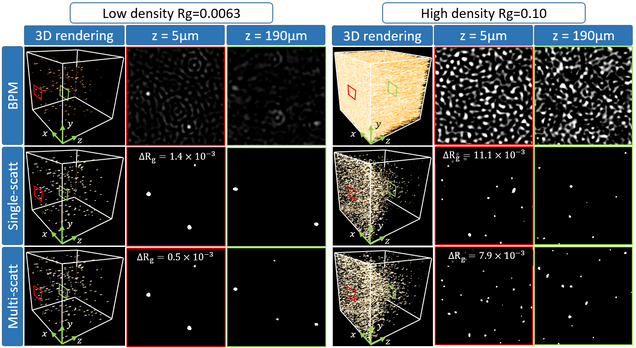
Compressive holographic video
Zihao Wang, Leonidas Spinoulas, Kuan He, Lei Tian, Oliver Cossairt, Aggelos K. Katsaggelos, and Huaijin Chen
Opt. Express 25, 250-262 (2017).
Compressed sensing has been discussed separately in spatial and temporal domains. Compressive holography has been introduced as a method that allows 3D tomographic reconstruction at different depths from a single 2D image. Coded exposure is a temporal compressed sensing method for high speed video acquisition. In this work, we combine compressive holography and coded exposure techniques and extend the discussion to 4D reconstruction in space and time from one coded captured image. In our prototype, digital in-line holography was used for imaging macroscopic, fast moving objects. The pixel-wise temporal modulation was implemented by a digital micromirror device. In this paper we demonstrate 10× temporal super resolution with multiple depths recovery from a single image. Two examples are presented for the purpose of recording subtle vibrations and tracking small particles within 5 ms.
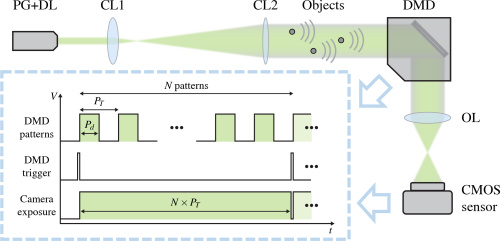
Compressive holographic two-dimensional localization with 1/302 subpixel accuracy
Y. Liu, Lei Tian, C. Hsieh, G. Barbastathis
Optics Express 22, 9774-9782 (2014).
We propose the use of compressive holography for two–dimensional (2D) subpixel motion localization. Our approach is based on computational implementation of edge–extraction using a Fourier–plane spiral phase mask, followed by compressive reconstruction of the edge of the object. Using this technique and relatively low–cost computer and piezo motion stage to establish ground truth for the motion, we demonstrated localization within 1/30th of a camera pixel in each linear dimension.
![]()
Scanning-free compressive holography for object localization with subpixel accuracy
Y. Liu, Lei Tian, J. W. Lee, H. Y. H. Huang, M. S. Triantafyllou, G. Barbastathis
Optics Letters 37, 3357-3359 (2012).
We propose quantitative localization measurement of a known object with subpixel accuracy using compressive holography. We analyze the theoretical optimal solution in the compressive sampling framework and experimentally demonstrate localization accuracy of 1/45 pixel, in good agreement with the analysis.
![]()
Quantitative measurement of size and three-dimensional position of fast moving bubbles in air-water mixture flows using digital holography
Lei Tian, N. Loomis, J. Dominguez-Caballero, G. Barbastathis
Applied Optics 49, 1549 (2010).
We present a digital in-line holographic imaging system for measuring the size and three-dimensional position of fast-moving bubbles in air–water mixture flows. The captured holograms are numerically processed by performing a two-dimensional projection followed by local depth estimation to quickly and efficiently obtain the size and position information of multiple bubbles simultaneously. Statistical analysis on measured bubble size distributions shows that they follow lognormal or gamma distributions.
